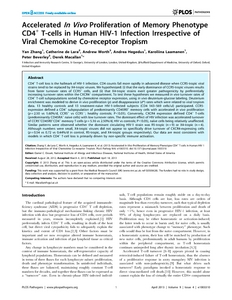Zhang, Y; de Lara, C; Worth, A; Hegedus, A; Laamanen, K; Beverley, P; Macallan, D
(2013)
Accelerated in vivo proliferation of memory phenotype CD4+ T-cells in human HIV-1 infection irrespective of viral chemokine co-receptor tropism.
PLOS PATHOGENS, 9 (4).
e1003310.
ISSN 1553-7374
https://doi.org/10.1371/journal.ppat.1003310
SGUL Authors: Macallan, Derek Clive Zhang, Yan
![[img]](https://openaccess.sgul.ac.uk/101477/1.hassmallThumbnailVersion/ppat.1003310.pdf)  Preview |
|
["document_typename_application/pdf; charset=binary" not defined]
Published Version
Download (799kB)
| Preview
|
Abstract
CD4(+) T-cell loss is the hallmark of HIV-1 infection. CD4 counts fall more rapidly in advanced disease when CCR5-tropic viral strains tend to be replaced by X4-tropic viruses. We hypothesized: (i) that the early dominance of CCR5-tropic viruses results from faster turnover rates of CCR5(+) cells, and (ii) that X4-tropic strains exert greater pathogenicity by preferentially increasing turnover rates within the CXCR4(+) compartment. To test these hypotheses we measured in vivo turnover rates of CD4(+) T-cell subpopulations sorted by chemokine receptor expression, using in vivo deuterium-glucose labeling. Deuterium enrichment was modeled to derive in vivo proliferation (p) and disappearance (d*) rates which were related to viral tropism data. 13 healthy controls and 13 treatment-naive HIV-1-infected subjects (CD4 143-569 cells/ul) participated. CCR5-expression defined a CD4(+) subpopulation of predominantly CD45R0(+) memory cells with accelerated in vivo proliferation (p = 2.50 vs 1.60%/d, CCR5(+) vs CCR5(-); healthy controls; P<0.01). Conversely, CXCR4 expression defined CD4(+) T-cells (predominantly CD45RA(+) naive cells) with low turnover rates. The dominant effect of HIV infection was accelerated turnover of CCR5(+)CD45R0(+)CD4(+) memory T-cells (p = 5.16 vs 2.50%/d, HIV vs controls; P<0.05), naïve cells being relatively unaffected. Similar patterns were observed whether the dominant circulating HIV-1 strain was R5-tropic (n = 9) or X4-tropic (n = 4). Although numbers were small, X4-tropic viruses did not appear to specifically drive turnover of CXCR4-expressing cells (p = 0.54 vs 0.72 vs 0.44%/d in control, R5-tropic, and X4-tropic groups respectively). Our data are most consistent with models in which CD4(+) T-cell loss is primarily driven by non-specific immune activation.
Statistics
Item downloaded times since 28 Jun 2013.
Actions (login required)
 |
Edit Item |




